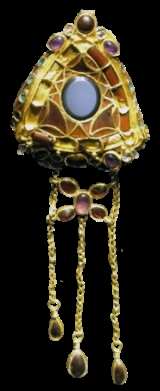
Fibulae and ancient brooches
Encyclopedia
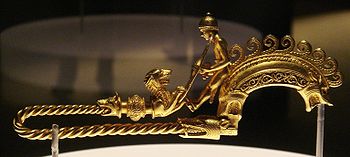
Brooch
A brooch ; also known in ancient times as a fibula; is a decorative jewelry item designed to be attached to garments. It is usually made of metal, often silver or gold but sometimes bronze or some other material...
. Technically, the Latin term, fibulae, refers to Roman
Ancient Rome
Ancient Rome was a thriving civilization that grew on the Italian Peninsula as early as the 8th century BC. Located along the Mediterranean Sea and centered on the city of Rome, it expanded to one of the largest empires in the ancient world....
brooches; however, the term is widely used to refer to brooches from the entire ancient and early medieval world that continue Roman forms. Nevertheless, its use in English is more restricted than in other languages, and in particular post-Roman brooches from the British Isles
British Isles
The British Isles are a group of islands off the northwest coast of continental Europe that include the islands of Great Britain and Ireland and over six thousand smaller isles. There are two sovereign states located on the islands: the United Kingdom of Great Britain and Northern Ireland and...
are just called brooches (for example, the penannular brooches), where in German they would probably be fibulae. Unlike most modern brooches, fibulae were not only decorative; they originally served a practical function: to fasten clothing, such as cloaks
Cloak
A cloak is a type of loose garment that is worn over indoor clothing and serves the same purpose as an overcoat; it protects the wearer from the cold, rain or wind for example, or it may form part of a fashionable outfit or uniform. Cloaks are as old as human history; there has nearly always been...
. Fibulae replaced straight pins
Pin
A pin is a device used for fastening objects or material together.Pin may also refer to:* Award pin, a small piece of metal or plastic with a pin attached given as an award for some achievement...
that were used to fasten clothing in the Neolithic
Neolithic
The Neolithic Age, Era, or Period, or New Stone Age, was a period in the development of human technology, beginning about 9500 BC in some parts of the Middle East, and later in other parts of the world. It is traditionally considered as the last part of the Stone Age...
period and the Bronze Age
Bronze Age
The Bronze Age is a period characterized by the use of copper and its alloy bronze as the chief hard materials in the manufacture of some implements and weapons. Chronologically, it stands between the Stone Age and Iron Age...
. In turn, fibulae were replaced as clothing fasteners by buttons
Button
In modern clothing and fashion design, a button is a small fastener, most commonly made of plastic, but also frequently of seashell, which secures two pieces of fabric together. In archaeology, a button can be a significant artifact. In the applied arts and in craft, a button can be an example of...
in the Middle Ages. Their descendant, the modern safety pin, remains in use today. In ancient Rome and other places where Latin was used, the same word denoted both a brooch and the fibula bone because a popular form for brooches and the shape of the bone were thought to resemble one another.
There are hundreds of different types of fibulae. They are usually divided into families that are based upon historical periods, geography, and/or cultures. Fibulae are also divided into classes that are based upon their general forms.
Construction
Most fibulae are made of bronzeBronze
Bronze is a metal alloy consisting primarily of copper, usually with tin as the main additive. It is hard and brittle, and it was particularly significant in antiquity, so much so that the Bronze Age was named after the metal...
(more properly "copper
Copper
Copper is a chemical element with the symbol Cu and atomic number 29. It is a ductile metal with very high thermal and electrical conductivity. Pure copper is soft and malleable; an exposed surface has a reddish-orange tarnish...
alloy
Alloy
An alloy is a mixture or metallic solid solution composed of two or more elements. Complete solid solution alloys give single solid phase microstructure, while partial solutions give two or more phases that may or may not be homogeneous in distribution, depending on thermal history...
") or iron
Iron
Iron is a chemical element with the symbol Fe and atomic number 26. It is a metal in the first transition series. It is the most common element forming the planet Earth as a whole, forming much of Earth's outer and inner core. It is the fourth most common element in the Earth's crust...
, or both. Some fibulae are made of precious metal
Precious metal
A precious metal is a rare, naturally occurring metallic chemical element of high economic value.Chemically, the precious metals are less reactive than most elements, have high lustre, are softer or more ductile, and have higher melting points than other metals...
s such as silver
Silver
Silver is a metallic chemical element with the chemical symbol Ag and atomic number 47. A soft, white, lustrous transition metal, it has the highest electrical conductivity of any element and the highest thermal conductivity of any metal...
or gold
Gold
Gold is a chemical element with the symbol Au and an atomic number of 79. Gold is a dense, soft, shiny, malleable and ductile metal. Pure gold has a bright yellow color and luster traditionally considered attractive, which it maintains without oxidizing in air or water. Chemically, gold is a...
. Most fibulae are made of only one or two pieces. Many fibulae are decorated with enamel
Vitreous enamel
Vitreous enamel, also porcelain enamel in U.S. English, is a material made by fusing powdered glass to a substrate by firing, usually between 750 and 850 °C...
, semi-precious stones, glass
Glass
Glass is an amorphous solid material. Glasses are typically brittle and optically transparent.The most familiar type of glass, used for centuries in windows and drinking vessels, is soda-lime glass, composed of about 75% silica plus Na2O, CaO, and several minor additives...
, coral
Coral (precious)
Precious coral or red coral is the common name given to Corallium rubrum and several related species of marine coral. The distinguishing characteristic of precious corals is their durable and intensely colored red or pink skeleton, which is used for making jewelry.-Habitat:Red corals grow on rocky...
or bone
Bone
Bones are rigid organs that constitute part of the endoskeleton of vertebrates. They support, and protect the various organs of the body, produce red and white blood cells and store minerals. Bone tissue is a type of dense connective tissue...
.
Components
_from_vrlse,_zealand,_denmark_(dr_em85123).jpg)
Body
The body of a fibula is known as either the bow or the plate, depending on the basic form. A bow is generally long and narrow, and often arched. A plate is flat and wide. Plates could be solid or openwork. The body was often decorated. The head is the end of the fibula with the springSpring (device)
A spring is an elastic object used to store mechanical energy. Springs are usually made out of spring steel. Small springs can be wound from pre-hardened stock, while larger ones are made from annealed steel and hardened after fabrication...
or hinge
Hinge
A hinge is a type of bearing that connects two solid objects, typically allowing only a limited angle of rotation between them. Two objects connected by an ideal hinge rotate relative to each other about a fixed axis of rotation. Hinges may be made of flexible material or of moving components...
. The foot is the end of the fibula where the pin closes. Depending on the type of fibula, and the culture
Culture
Culture is a term that has many different inter-related meanings. For example, in 1952, Alfred Kroeber and Clyde Kluckhohn compiled a list of 164 definitions of "culture" in Culture: A Critical Review of Concepts and Definitions...
in question, the head of the fibula could be worn facing up, down or to the side.
Pin
The pin that is used to fasten the clothingClothing
Clothing refers to any covering for the human body that is worn. The wearing of clothing is exclusively a human characteristic and is a feature of nearly all human societies...
is either a continuation of the fibula's body or a separate piece attached to the body. The fibula is closed by connecting the end of the pin to a catch plate, or pin rest.
Spring
The body and pin meet at either a spring or hingeHinge
A hinge is a type of bearing that connects two solid objects, typically allowing only a limited angle of rotation between them. Two objects connected by an ideal hinge rotate relative to each other about a fixed axis of rotation. Hinges may be made of flexible material or of moving components...
. The earliest design is the spring which provides tension to the pin. The spring could be unilateral or bilateral. A unilateral spring winds around in one direction only. Unilateral springs are the earliest type, first appearing around the 14th century BC. Bilateral springs that wind around to both sides of the fibula body, appeared around the 6th century BC. Bilateral springs can be very short, with only one or two revolutions per side, or up to 10 cm long. Most bilateral springs are made of one piece of metal and therefore have a spring cord, a piece of wire extending from one end of the spring to the other. The spring cord can pass in front of or behind the fibulae body. Bilateral springs wrap around a pin or axle. These are usually made of iron even if the rest of the fibula and spring is copper alloy. In the 1st century AD some fibulae had springs that were concealed under a metal cover that was an extension of the fibula body. These are known as covered springs, or hidden springs.
Hinge
In the late 1st century BC or early 1st century AD a new design appeared in some bow type fibulae. A separate pin was attached to the head-end of the bow with a small hingeHinge
A hinge is a type of bearing that connects two solid objects, typically allowing only a limited angle of rotation between them. Two objects connected by an ideal hinge rotate relative to each other about a fixed axis of rotation. Hinges may be made of flexible material or of moving components...
. In the second half of the 1st century AD, hinges were introduced to plate type fibulae. One or two small plaques were cast on the back of the plate and a pin was attached to them by a small hinge. Previously, plate type fibulae had bilateral springs attached to the back. In the 3rd century AD, the hinge was placed in the centre of a long transverse bar creating the famous crossbow
Crossbow
A crossbow is a weapon consisting of a bow mounted on a stock that shoots projectiles, often called bolts or quarrels. The medieval crossbow was called by many names, most of which derived from the word ballista, a torsion engine resembling a crossbow in appearance.Historically, crossbows played a...
fibula design. A few fibulae from a much earlier date also had hinges, although this design feature was very rare and soon died out for nearly five centuries. For example, the Asia Minor
Asia Minor
Asia Minor is a geographical location at the westernmost protrusion of Asia, also called Anatolia, and corresponds to the western two thirds of the Asian part of Turkey...
Decorated Arc Fibula (Blinkenberg Type XII Variation 16) dating to the 5th century BC.
It is important to note that different types of fibula construction were used contemporaneously. Though the introduction of the hinge was later than the introduction of the spring, the spring remained in use long after the hinge was introduced. Therefore, a given fibula with hinge is not necessarily more recent than one with a spring.
Use
Fibulae were originally used to fasten clothingClothing
Clothing refers to any covering for the human body that is worn. The wearing of clothing is exclusively a human characteristic and is a feature of nearly all human societies...
. They represent an improvement on the earlier straight pin
Pin
A pin is a device used for fastening objects or material together.Pin may also refer to:* Award pin, a small piece of metal or plastic with a pin attached given as an award for some achievement...
which was less secure and could fall out. While the head of the earlier straight pin was often decorated, the bow or plate of the fibula provided a much increased scope for decoration. Among some culture
Culture
Culture is a term that has many different inter-related meanings. For example, in 1952, Alfred Kroeber and Clyde Kluckhohn compiled a list of 164 definitions of "culture" in Culture: A Critical Review of Concepts and Definitions...
s, different fibula designs had specific symbolic meanings. They could refer to a status or profession such as single woman, married woman, man, warrior, or chief. Some Roman-era fibulae may symbolize specific ranks or positions in the Roman legion
Roman legion
A Roman legion normally indicates the basic ancient Roman army unit recruited specifically from Roman citizens. The organization of legions varied greatly over time but they were typically composed of perhaps 5,000 soldiers, divided into maniples and later into "cohorts"...
s or auxiliary. In some cultures, fibulae were worn in pairs and could be linked by a length of chain.
Bronze Age fibulae

Safety pin
A safety pin is a simple fastening device, a variation of the regular pin which includes a simple spring mechanism and a clasp. The clasp serves two purposes: to form a closed loop thereby properly fastening the pin to whatever it is applied to, and to cover the end of the pin to protect the user...
. The violin bow fibula has a low flat arch; the body runs parallel to the pin so it resembles a violin
Violin
The violin is a string instrument, usually with four strings tuned in perfect fifths. It is the smallest, highest-pitched member of the violin family of string instruments, which includes the viola and cello....
bow. The bow could be round, square, or flat and ribbon-like in cross-section. Some had simple punched or incised decoration on the bow. Violin bow fibula, such as the Peschiera type and the Unter-Radl type, was introduced in the 14th century BC (Late Mycenean III era) by the Mycenean
Mycenaean Greece
Mycenaean Greece was a cultural period of Bronze Age Greece taking its name from the archaeological site of Mycenae in northeastern Argolis, in the Peloponnese of southern Greece. Athens, Pylos, Thebes, and Tiryns are also important Mycenaean sites...
s on the Greek Peloponnesus. The fibula soon spread to Crete
Crete
Crete is the largest and most populous of the Greek islands, the fifth largest island in the Mediterranean Sea, and one of the thirteen administrative regions of Greece. It forms a significant part of the economy and cultural heritage of Greece while retaining its own local cultural traits...
, Cyprus
Cyprus
Cyprus , officially the Republic of Cyprus , is a Eurasian island country, member of the European Union, in the Eastern Mediterranean, east of Greece, south of Turkey, west of Syria and north of Egypt. It is the third largest island in the Mediterranean Sea.The earliest known human activity on the...
and Mycenean
Mycenaean Greece
Mycenaean Greece was a cultural period of Bronze Age Greece taking its name from the archaeological site of Mycenae in northeastern Argolis, in the Peloponnese of southern Greece. Athens, Pylos, Thebes, and Tiryns are also important Mycenaean sites...
trading posts in Sicily
Sicily
Sicily is a region of Italy, and is the largest island in the Mediterranean Sea. Along with the surrounding minor islands, it constitutes an autonomous region of Italy, the Regione Autonoma Siciliana Sicily has a rich and unique culture, especially with regard to the arts, music, literature,...
.
There were several variants of the violin bow fibula. The bow could bend, or zig-zag from side to side while still remaining flat and parallel to the pin. These variants, such as the Grunwald type and the Hanua type, were found in the 12th and 11th centuries BC. In another variant, the bow, while still flat, widened out into an oval or diamond shape (blattbugel in German). These variants, such as the Kreuznach type and Reisen type, were found in the 12th to 10th centuries BC.
The second major design of fibula has a high, rounded arch
Arch
An arch is a structure that spans a space and supports a load. Arches appeared as early as the 2nd millennium BC in Mesopotamian brick architecture and their systematic use started with the Ancient Romans who were the first to apply the technique to a wide range of structures.-Technical aspects:The...
(bogen in German) instead of the low flat arch of the violin bow fibula. At first, the bow was thin. In later variants the bow was made of thicker metal or of two pieces of thin wire
Wire
A wire is a single, usually cylindrical, flexible strand or rod of metal. Wires are used to bear mechanical loads and to carry electricity and telecommunications signals. Wire is commonly formed by drawing the metal through a hole in a die or draw plate. Standard sizes are determined by various...
twisted together. These rounded bow fibulae were first found in the 12th century BC, but lasted in use in some places for more than five centuries.
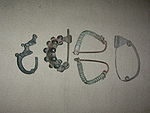
Spiral
In mathematics, a spiral is a curve which emanates from a central point, getting progressively farther away as it revolves around the point.-Spiral or helix:...
s. The spectacle fibula (brillen in German) consisted of two spirals joined together. It resembles a pair of spectacles or eye glasses
Glasses
Glasses, also known as eyeglasses , spectacles or simply specs , are frames bearing lenses worn in front of the eyes. They are normally used for vision correction or eye protection. Safety glasses are a kind of eye protection against flying debris or against visible and near visible light or...
. These fibulae, such as the Haslau type and the St. Lucija type, were found in the 9th to 7th centuries BC. Some spectacle fibula were very large with spirals up to 10 cm across. A variant that appeared in the 6th century BC had four small spirals with a square, or squarish, cover plate on the middle, the Vierpass type.
The Villanovan culture
Villanovan culture
The Villanovan culture was the earliest Iron Age culture of central and northern Italy, abruptly following the Bronze Age Terramare culture and giving way in the 7th century BC to an increasingly orientalizing culture influenced by Greek traders, which was followed without a severe break by the...
in Italy
Italy
Italy , officially the Italian Republic languages]] under the European Charter for Regional or Minority Languages. In each of these, Italy's official name is as follows:;;;;;;;;), is a unitary parliamentary republic in South-Central Europe. To the north it borders France, Switzerland, Austria and...
introduced a series of variations of the bow fibula in the 8th and 7th centuries BC. In these so-called Italiante fibulae, the bow begins, at the head, with a semi-circular form, but bends at its apex to angle straight down to the foot that was often lengthened and extended. The bow was often decorated with moulded knobs or spikes. The rear half of the bow was sometimes bent into a wavy, kinked shape. The latter variants were known as serpentine
Serpentine shape
Serpentine refers to the curved shape of an object or design which resembles the letter s, a sine wave or a snake; the latter is the derivation of the term.- Examples :* The Serpentine River...
fibulae.
Meanwhile, the 8th and 7th centuries BC saw the introduction of the so-called Phrygia
Phrygia
In antiquity, Phrygia was a kingdom in the west central part of Anatolia, in what is now modern-day Turkey. The Phrygians initially lived in the southern Balkans; according to Herodotus, under the name of Bryges , changing it to Phruges after their final migration to Anatolia, via the...
n bow fibulae in Asia Minor
Asia Minor
Asia Minor is a geographical location at the westernmost protrusion of Asia, also called Anatolia, and corresponds to the western two thirds of the Asian part of Turkey...
. These fibulae had a near-perfect semi-circular arch sometimes decorated with knobs or round flanges. In the same period, the Hand or Arm fibula spread from Cyprus
Cyprus
Cyprus , officially the Republic of Cyprus , is a Eurasian island country, member of the European Union, in the Eastern Mediterranean, east of Greece, south of Turkey, west of Syria and north of Egypt. It is the third largest island in the Mediterranean Sea.The earliest known human activity on the...
, where it appears to have originated, to Syria
Syria
Syria , officially the Syrian Arab Republic , is a country in Western Asia, bordering Lebanon and the Mediterranean Sea to the West, Turkey to the north, Iraq to the east, Jordan to the south, and Israel to the southwest....
, Assyria
Assyria
Assyria was a Semitic Akkadian kingdom, extant as a nation state from the mid–23rd century BC to 608 BC centred on the Upper Tigris river, in northern Mesopotamia , that came to rule regional empires a number of times through history. It was named for its original capital, the ancient city of Assur...
and Persia. In this design the bow was bent 90 degrees at the apex giving the fibula a triangular shape when viewed from the side. The bow was usually decorated with a series of rings and dots. The catch plate usually had the form of a hand, making the entire fibula resemble an arm.
In the 7th and 6th centuries BC, a series of variations of the bow fibula appeared in the southern Balkans
Balkans
The Balkans is a geopolitical and cultural region of southeastern Europe...
, known variously as Greek
Greece
Greece , officially the Hellenic Republic , and historically Hellas or the Republic of Greece in English, is a country in southeastern Europe....
, Macedonian
Ancient Macedonians
The Macedonians originated from inhabitants of the northeastern part of the Greek peninsula, in the alluvial plain around the rivers Haliacmon and lower Axios...
, or Thracian bow fibulae. The high arched bow of these fibulae had large fins or knobs. The bow usually ended in a very large triangular or square catch plate. Some of the large square catch plates were decorated with complex incised geometric or figural designs. Some of the fibula had a flat back indicating that they were likely cast in simple, open moulds.
Iron Age fibulae
The Iron AgeIron Age
The Iron Age is the archaeological period generally occurring after the Bronze Age, marked by the prevalent use of iron. The early period of the age is characterized by the widespread use of iron or steel. The adoption of such material coincided with other changes in society, including differing...
saw an expansion in the use of fibulae. The rounded bow fibula underwent several variations and were usually highly decorated with incised or moulded geometric designs. In one variation, the foot of the fibula that had previously terminated at the end of the arch with a simple catch plate, lengthened significantly. These extended foot fibulae, such as the Kahn type and the Pauken type, were found in the 7th to 5th centuries BC. The first long, bilateral springs appeared on some of these variants in the Hallstatt
Hallstatt
Hallstatt, Upper Austria is a village in the Salzkammergut, a region in Austria. It is located near the Hallstätter See . At the 2001 census it had 946 inhabitants...
D2 era (5th century BC). These fibulae, such as the Doublezier type, looked similar to the Roman-era crossbow
Crossbow
A crossbow is a weapon consisting of a bow mounted on a stock that shoots projectiles, often called bolts or quarrels. The medieval crossbow was called by many names, most of which derived from the word ballista, a torsion engine resembling a crossbow in appearance.Historically, crossbows played a...
fibulae but were not the latter’s direct precursor.
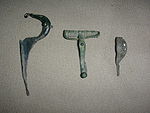
In another variation of the rounded bow fibula, the bow became fat and swollen-looking. In many of these Leech
Leech
Leeches are segmented worms that belong to the phylum Annelida and comprise the subclass Hirudinea. Like other oligochaetes such as earthworms, leeches share a clitellum and are hermaphrodites. Nevertheless, they differ from other oligochaetes in significant ways...
Bow, or Sanguisaga, fibulae the catch plate became large and triangular. Another variant, the Certossa type, had a small square or ribbon cross-section bow and a short bilateral spring (possibly the first use of a bilateral spring). Certossa fibulae are almost always very small.
In the La Tene I, or La Tene A to B2, era (4th to 3rd centuries BC), fibula design became relatively standardised over a large geographic area, although minor stylistic variations and differences in decoration remained. The La Tene I fibula usually had a narrow bow. The spring that could be either unilateral or bilateral, was wound in a fairly large diameter circle. The foot was turned up and usually ended in a decorated knob or with an applied bead
Bead
A bead is a small, decorative object that is usually pierced for threading or stringing. Beads range in size from under to over in diameter. A pair of beads made from Nassarius sea snail shells, approximately 100,000 years old, are thought to be the earliest known examples of jewellery. Beadwork...
or stone. In some cases the raised foot was bent back towards the bow, although it did not touch the bow. The Thraco-Getic fibula is a variant found in the eastern Balkans
Balkans
The Balkans is a geopolitical and cultural region of southeastern Europe...
and used by the Getae
Getae
The Getae was the name given by the Greeks to several Thracian tribes that occupied the regions south of the Lower Danube, in what is today northern Bulgaria, and north of the Lower Danube, in Romania...
. The fibula's foot is vertical and ends in a small knob, though later models had a sinuous, s-shaped profile.
The La Tene I era also saw the introduction of the first animal, or zoomorphic, designs. These included birds and horse
Horse
The horse is one of two extant subspecies of Equus ferus, or the wild horse. It is a single-hooved mammal belonging to the taxonomic family Equidae. The horse has evolved over the past 45 to 55 million years from a small multi-toed creature into the large, single-toed animal of today...
s and could either be flat, with a short bilateral spring on the back, or three-dimensional
Dimension
In physics and mathematics, the dimension of a space or object is informally defined as the minimum number of coordinates needed to specify any point within it. Thus a line has a dimension of one because only one coordinate is needed to specify a point on it...
("in the round") with a long bilateral spring at the head.
In the La Tene II, or La Tene C era (2nd century BC), the foot of the fibula actually bent back to touch the bow and was wrapped around it. Many La Tene II fibulae had long bilateral springs. It is important to be aware that this type of construction was in use several centuries later in the tied-foot and returned-foot types of fibulae. These latter types are sometimes known as pseudo-La Tene fibulae.
In the La Tene III, or La Tene D era (1st century BC), the raised foot was no longer wrapped around the bow but was attached directly to it by casting
Casting
In metalworking, casting involves pouring liquid metal into a mold, which contains a hollow cavity of the desired shape, and then allowing it to cool and solidify. The solidified part is also known as a casting, which is ejected or broken out of the mold to complete the process...
or welding
Welding
Welding is a fabrication or sculptural process that joins materials, usually metals or thermoplastics, by causing coalescence. This is often done by melting the workpieces and adding a filler material to form a pool of molten material that cools to become a strong joint, with pressure sometimes...
creating a loop above the foot. In one variant, the Nauheim type, the bow widened into a flat triangle or diamond. In another variant, the Schussel type, the ribbon-like bow widened at the head into a rounded arrowhead
Arrowhead
An arrowhead is a tip, usually sharpened, added to an arrow to make it more deadly or to fulfill some special purpose. Historically arrowheads were made of stone and of organic materials; as human civilization progressed other materials were used...
shape that covered the spring.
The 1st century AD
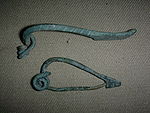
Roman Empire
The Roman Empire was the post-Republican period of the ancient Roman civilization, characterised by an autocratic form of government and large territorial holdings in Europe and around the Mediterranean....
by the 1st century AD resulted in a tremendous growth in the number and design of fibulae throughout Europe
Europe
Europe is, by convention, one of the world's seven continents. Comprising the westernmost peninsula of Eurasia, Europe is generally 'divided' from Asia to its east by the watershed divides of the Ural and Caucasus Mountains, the Ural River, the Caspian and Black Seas, and the waterways connecting...
and the Near East
Near East
The Near East is a geographical term that covers different countries for geographers, archeologists, and historians, on the one hand, and for political scientists, economists, and journalists, on the other...
. The spread of technologically advanced workshops in the Roman Empire led to more complex fibula designs. Bows were cast in more complex forms, hinges appeared alongside bilateral springs and a wide variety of plate designs were introduced.
One of the first fibula designs of the Roman-era began in the La Tene III era, in the late 1st century BC. The Straight Wire fibula, also known as the Soldier’s type or Legionnaire
Roman legion
A Roman legion normally indicates the basic ancient Roman army unit recruited specifically from Roman citizens. The organization of legions varied greatly over time but they were typically composed of perhaps 5,000 soldiers, divided into maniples and later into "cohorts"...
's type, is a very plain design. It resembles the violin bow fibula of over one thousand years earlier except that the bow has slightly more of an arch and the spring in (short) bilateral not unilateral. The Straight Wire fibula is found through the 1st century AD.
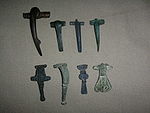
Roman Britain
Roman Britain was the part of the island of Great Britain controlled by the Roman Empire from AD 43 until ca. AD 410.The Romans referred to the imperial province as Britannia, which eventually comprised all of the island of Great Britain south of the fluid frontier with Caledonia...
. Perhaps the most distinctive British fibula design was the Dolphin. This was actually a series of designs including the Polden Hill type, the Langton Down type, the Colchester type and the T-Shaped type. Dolphin fibulae have a smooth arched bow that tapers from the head to end in a long point. The long bilateral spring is covered. From the top the Dolphin fibula looks like a T or the late-Roman crossbow
Crossbow
A crossbow is a weapon consisting of a bow mounted on a stock that shoots projectiles, often called bolts or quarrels. The medieval crossbow was called by many names, most of which derived from the word ballista, a torsion engine resembling a crossbow in appearance.Historically, crossbows played a...
fibula. From the side it resembles a leaping dolphin
Dolphin
Dolphins are marine mammals that are closely related to whales and porpoises. There are almost forty species of dolphin in 17 genera. They vary in size from and , up to and . They are found worldwide, mostly in the shallower seas of the continental shelves, and are carnivores, mostly eating...
.
Another British design was the Hod Hill type. Usually quite small, Hod Hill fibulae have a shallow arched bow that appears to be made up of lumpy segments. Many Hod Hill fibulae have a pair of small side lug
Lug (knob)
A Lug is a typically flattened protuberance, a knob, or extrusion on the side of a vessel: pottery, jug, glass, vase, etc. They are sometimes found on prehistoric ceramics/stone-vessels such as pots from Ancient Egypt, Hembury ware, claw beakers, and boar spears.A lug may also only be shaped as a...
s.
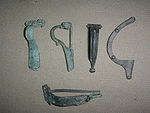
Roman Empire
The Roman Empire was the post-Republican period of the ancient Roman civilization, characterised by an autocratic form of government and large territorial holdings in Europe and around the Mediterranean....
by Germanic peoples
Germanic peoples
The Germanic peoples are an Indo-European ethno-linguistic group of Northern European origin, identified by their use of the Indo-European Germanic languages which diversified out of Proto-Germanic during the Pre-Roman Iron Age.Originating about 1800 BCE from the Corded Ware Culture on the North...
, notably Marcomanni
Marcomanni
The Marcomanni were a Germanic tribe, probably related to the Buri, Suebi or Suevi.-Origin:Scholars believe their name derives possibly from Proto-Germanic forms of "march" and "men"....
, serving as Roman auxiliaries.
The Aucissa fibula was another widespread design. It has a high semi-circular arched bow that extended into a short foot. The bow is flat and wide and has a rounded central ridge. The bow ends, at the head, in a hinge. The Aucissa was one of the first fibulae to use a hinge instead of a spring. The foot ends in a rounded knob. Many Aucissa fibulae have the word “AVCISSA” moulded above the hinge. This is thought to be the name of a workshop
Workshop
A workshop is a room or building which provides both the area and tools that may be required for the manufacture or repair of manufactured goods...
.
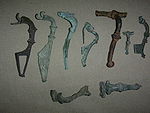
Crescent
In art and symbolism, a crescent is generally the shape produced when a circular disk has a segment of another circle removed from its edge, so that what remains is a shape enclosed by two circular arcs of different diameters which intersect at two points .In astronomy, a crescent...
at the head giving the fibula an anchor
Anchor
An anchor is a device, normally made of metal, that is used to connect a vessel to the bed of a body of water to prevent the vessel from drifting due to wind or current. The word derives from Latin ancora, which itself comes from the Greek ἄγκυρα .Anchors can either be temporary or permanent...
shape. The Thracian Anchor type is also called the Illyrian and is found in Pannonia
Pannonia
Pannonia was an ancient province of the Roman Empire bounded north and east by the Danube, coterminous westward with Noricum and upper Italy, and southward with Dalmatia and upper Moesia....
(Hungary
Hungary
Hungary , officially the Republic of Hungary , is a landlocked country in Central Europe. It is situated in the Carpathian Basin and is bordered by Slovakia to the north, Ukraine and Romania to the east, Serbia and Croatia to the south, Slovenia to the southwest and Austria to the west. The...
), Dacia
Dacia
In ancient geography, especially in Roman sources, Dacia was the land inhabited by the Dacians or Getae as they were known by the Greeks—the branch of the Thracians north of the Haemus range...
(Romania
Romania
Romania is a country located at the crossroads of Central and Southeastern Europe, on the Lower Danube, within and outside the Carpathian arch, bordering on the Black Sea...
) and Serbia
Serbia
Serbia , officially the Republic of Serbia , is a landlocked country located at the crossroads of Central and Southeast Europe, covering the southern part of the Carpathian basin and the central part of the Balkans...
.
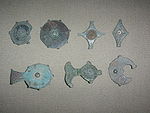
Bell (instrument)
A bell is a simple sound-making device. The bell is a percussion instrument and an idiophone. Its form is usually a hollow, cup-shaped object, which resonates upon being struck...
-shaped head and a long thin pointy foot. They have long bilateral hinges. There are three main variations of the Kraftig Profilierte fibula. The North Pannonian Double Knot type, found in Pannonia
Pannonia
Pannonia was an ancient province of the Roman Empire bounded north and east by the Danube, coterminous westward with Noricum and upper Italy, and southward with Dalmatia and upper Moesia....
has two knobs, or knots, on the bow. The Single Knot type, found in the central Balkans
Balkans
The Balkans is a geopolitical and cultural region of southeastern Europe...
, has a single knob. The Black Sea type, found in the steppes north of the Black Sea
Black Sea
The Black Sea is bounded by Europe, Anatolia and the Caucasus and is ultimately connected to the Atlantic Ocean via the Mediterranean and the Aegean seas and various straits. The Bosphorus strait connects it to the Sea of Marmara, and the strait of the Dardanelles connects that sea to the Aegean...
, has a thin body, with no flaring near the head, and two knots. Kraftig Profilierte fibulae were found in the late 1st to late 2nd centuries AD and are mostly associated with the Przeworsk
Przeworsk
Przeworsk Ukrainian: Переворськ, is a town in south-eastern Poland with 15,675 inhabitants, as of 2 June 2009. Since 1999 it has been in the Subcarpathian Voivodeship, and is the capital of Przeworsk County....
proto-Gothic
Goths
The Goths were an East Germanic tribe of Scandinavian origin whose two branches, the Visigoths and the Ostrogoths, played an important role in the fall of the Roman Empire and the emergence of Medieval Europe....
culture.
The 1st century AD saw the widespread use of plate fibulae. Plate fibulae consist of a flat plate. Since there is little space between the fibula body and the pin (there is no arch to the body), plate fibulae could not be used to fasten much material and were therefore mainly decorative. Most plate fibulae have a hinge assembly on the back. Plate fibulae are generally associated with women’s grave
Grave (burial)
A grave is a location where a dead body is buried. Graves are usually located in special areas set aside for the purpose of burial, such as graveyards or cemeteries....
s. The most common forms of plate fibula in the 1st century AD were round (disc), diamond, oval and lunula
Lunula
The word lunula means little moon and commonly refers to:* Lunula * Two round brackets and the text between them* A type of necklace shaped like a crescent moon...
(crescent
Crescent
In art and symbolism, a crescent is generally the shape produced when a circular disk has a segment of another circle removed from its edge, so that what remains is a shape enclosed by two circular arcs of different diameters which intersect at two points .In astronomy, a crescent...
- or moon-shaped).
The 2nd century AD
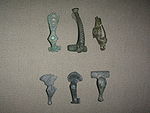
Roman Britain
Roman Britain was the part of the island of Great Britain controlled by the Roman Empire from AD 43 until ca. AD 410.The Romans referred to the imperial province as Britannia, which eventually comprised all of the island of Great Britain south of the fluid frontier with Caledonia...
the fibula designs common in the 1st century AD continued to some extent into the second, although usually in more complex variations. A new design, the Head Stud type, has a long bow with a stud, or occasionally a ring, at the head.
The Knee fibula, a common design in the 2nd century AD, originated in Roman Pannonia
Pannonia
Pannonia was an ancient province of the Roman Empire bounded north and east by the Danube, coterminous westward with Noricum and upper Italy, and southward with Dalmatia and upper Moesia....
(modern Hungary
Hungary
Hungary , officially the Republic of Hungary , is a landlocked country in Central Europe. It is situated in the Carpathian Basin and is bordered by Slovakia to the north, Ukraine and Romania to the east, Serbia and Croatia to the south, Slovenia to the southwest and Austria to the west. The...
). With its short, fat bow that incorporates a 90 degree bend, archeologists thought it resembled a knee
Knee
The knee joint joins the thigh with the leg and consists of two articulations: one between the fibula and tibia, and one between the femur and patella. It is the largest joint in the human body and is very complicated. The knee is a mobile trocho-ginglymus , which permits flexion and extension as...
and leg. Many Knee fibulae have small rectangular, or larger semi-circular head plates. Knee fibulae appear, like the Augen type, to have been introduced into the Roman Empire
Roman Empire
The Roman Empire was the post-Republican period of the ancient Roman civilization, characterised by an autocratic form of government and large territorial holdings in Europe and around the Mediterranean....
by Germanic
Germanic peoples
The Germanic peoples are an Indo-European ethno-linguistic group of Northern European origin, identified by their use of the Indo-European Germanic languages which diversified out of Proto-Germanic during the Pre-Roman Iron Age.Originating about 1800 BCE from the Corded Ware Culture on the North...
allies. Despite their small size, their appearance in Roman military graves implies that the Knee fibula was the most popular fibula among Roman soldiers in the 2nd century AD. They are rarely found outside military sites or contexts.
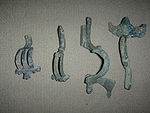
Trumpet
The trumpet is the musical instrument with the highest register in the brass family. Trumpets are among the oldest musical instruments, dating back to at least 1500 BCE. They are played by blowing air through closed lips, producing a "buzzing" sound which starts a standing wave vibration in the air...
. However, unlike a straight trumpet, the Pannonian Trumpet fibula is sharply bent near the head. This Germanic
Germanic peoples
The Germanic peoples are an Indo-European ethno-linguistic group of Northern European origin, identified by their use of the Indo-European Germanic languages which diversified out of Proto-Germanic during the Pre-Roman Iron Age.Originating about 1800 BCE from the Corded Ware Culture on the North...
design was found in and around Pannonia
Pannonia
Pannonia was an ancient province of the Roman Empire bounded north and east by the Danube, coterminous westward with Noricum and upper Italy, and southward with Dalmatia and upper Moesia....
but was exported as widely as Britain
Roman Britain
Roman Britain was the part of the island of Great Britain controlled by the Roman Empire from AD 43 until ca. AD 410.The Romans referred to the imperial province as Britannia, which eventually comprised all of the island of Great Britain south of the fluid frontier with Caledonia...
.
The P-Shaped type is another common 2nd century AD fibula design that originated among the Germanic peoples
Germanic peoples
The Germanic peoples are an Indo-European ethno-linguistic group of Northern European origin, identified by their use of the Indo-European Germanic languages which diversified out of Proto-Germanic during the Pre-Roman Iron Age.Originating about 1800 BCE from the Corded Ware Culture on the North...
. The P-Shaped fibula, or Almgren Type 162, has a semi-circular arch and a long foot that curves back under itself to return to the base of the arch. They have bilateral springs. The bows of P-Shaped fibulae are usually semi-circular in cross-section and are decorated with ribs. P-Shaped fibulae were found from the 2nd to the early 4th centuries.
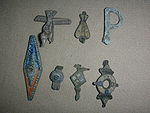
Trident
A trident , also called a trishul or leister or gig, is a three-pronged spear. It is used for spear fishing and was also a military weapon. Tridents are featured widely in mythical, historical and modern culture. The major Hindu god, Shiva the Destroyer and the sea god Poseidon or Neptune are...
. Claims that this was the standard fibula of the Roman navy
Roman Navy
The Roman Navy comprised the naval forces of the Ancient Roman state. Although the navy was instrumental in the Roman conquest of the Mediterranean basin, it never enjoyed the prestige of the Roman legions...
are unfounded.
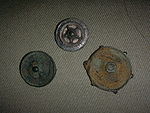
Vitreous enamel
Vitreous enamel, also porcelain enamel in U.S. English, is a material made by fusing powdered glass to a substrate by firing, usually between 750 and 850 °C...
led versions or more complex shapes. These included animal (zoomorphic) shapes (birds, horse
Horse
The horse is one of two extant subspecies of Equus ferus, or the wild horse. It is a single-hooved mammal belonging to the taxonomic family Equidae. The horse has evolved over the past 45 to 55 million years from a small multi-toed creature into the large, single-toed animal of today...
s, rabbit
Rabbit
Rabbits are small mammals in the family Leporidae of the order Lagomorpha, found in several parts of the world...
s, flies, etc.), letters or words, abstract symmetrical or asymmetrical designs (including the so-called Celt
Celt
The Celts were a diverse group of tribal societies in Iron Age and Roman-era Europe who spoke Celtic languages.The earliest archaeological culture commonly accepted as Celtic, or rather Proto-Celtic, was the central European Hallstatt culture , named for the rich grave finds in Hallstatt, Austria....
ic Trumpet designs), and skeumorphic designs (symbol
Symbol
A symbol is something which represents an idea, a physical entity or a process but is distinct from it. The purpose of a symbol is to communicate meaning. For example, a red octagon may be a symbol for "STOP". On a map, a picture of a tent might represent a campsite. Numerals are symbols for...
ic designs). Most designs continued in use throughout the 2nd and 3rd centuries. In one later variation during this time, the Tutulus type, the circular disc plate was extended upwards to form a cone
Cone (geometry)
A cone is an n-dimensional geometric shape that tapers smoothly from a base to a point called the apex or vertex. Formally, it is the solid figure formed by the locus of all straight line segments that join the apex to the base...
.
The 3rd to 4th centuries AD
The use of enamelVitreous enamel
Vitreous enamel, also porcelain enamel in U.S. English, is a material made by fusing powdered glass to a substrate by firing, usually between 750 and 850 °C...
led inlay
Inlay
Inlay is a decorative technique of inserting pieces of contrasting, often coloured materials into depressions in a base object to form patterns or pictures that normally are flush with the matrix. In a wood matrix, inlays commonly use wood veneers, but other materials like shells, mother-of-pearl,...
continued until the end of the 3rd century AD.
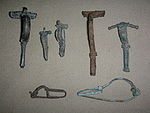
Goths
The Goths were an East Germanic tribe of Scandinavian origin whose two branches, the Visigoths and the Ostrogoths, played an important role in the fall of the Roman Empire and the emergence of Medieval Europe....
culture.
The classic fibula of the late-Roman era, and in fact the best known of all fibula types, is the crossbow
Crossbow
A crossbow is a weapon consisting of a bow mounted on a stock that shoots projectiles, often called bolts or quarrels. The medieval crossbow was called by many names, most of which derived from the word ballista, a torsion engine resembling a crossbow in appearance.Historically, crossbows played a...
type. The crossbow fibula consists of a highly arched semi-circular bow, usually of squarish cross-section, and a long flat foot. The fibula has a wide transverse bar (or arms) at the head containing the pin-hinge. Crossbow fibulae usually have three round or onion-shaped knobs: one at the head and one at each end of the transverse bar.
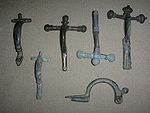
Curlicue
A curlicue, or alternatively curlycue, in the visual arts, is a fancy twist, or curl, composed usually from a series of concentric circles...
s. Another variant, dating to the 4th and 5th centuries, the Bugelkopf type, has no transverse bar, or arms at all but retains the round knob at the head.
Post-Roman fibulae

Goths
The Goths were an East Germanic tribe of Scandinavian origin whose two branches, the Visigoths and the Ostrogoths, played an important role in the fall of the Roman Empire and the emergence of Medieval Europe....
group of bow fibulae have a round or triangular flat head plate, often with 3, 5 or 7 knobs, a small arched bow and a long flat diamond shaped foot. They were widely used by the Germanic
Germanic peoples
The Germanic peoples are an Indo-European ethno-linguistic group of Northern European origin, identified by their use of the Indo-European Germanic languages which diversified out of Proto-Germanic during the Pre-Roman Iron Age.Originating about 1800 BCE from the Corded Ware Culture on the North...
Visigoths, Ostrogoths, and Gepids, and the non-Germanic Slavs and Avars
Eurasian Avars
The Eurasian Avars or Ancient Avars were a highly organized nomadic confederacy of mixed origins. They were ruled by a khagan, who was surrounded by a tight-knit entourage of nomad warriors, an organization characteristic of Turko-Mongol groups...
, and are found over a wide part of southern and western Europe in the 5th and 6th centuries AD. There are also a wide variety of Anglo-Saxon
Anglo-Saxons
Anglo-Saxon is a term used by historians to designate the Germanic tribes who invaded and settled the south and east of Great Britain beginning in the early 5th century AD, and the period from their creation of the English nation to the Norman conquest. The Anglo-Saxon Era denotes the period of...
fibulae from the 5th to 7th century such as the equal-arm type and the small-long type. Most Viking
Viking
The term Viking is customarily used to refer to the Norse explorers, warriors, merchants, and pirates who raided, traded, explored and settled in wide areas of Europe, Asia and the North Atlantic islands from the late 8th to the mid-11th century.These Norsemen used their famed longships to...
fibulae are variations on the ring or annular design (see below).
Ring fibulae and penannular brooches
The ring, or annular, fibula or brooch is extremely hard to date as the design for utilitarian pieces was almost unchanged from the 2nd to the 14th centuries AD. If there is decoration, this is likely to indicate whether a given ring fibula is Roman-era fibula or a medieval brooch.The penannular brooch, with an incomplete ring and two terminals, originally a common utilitarian clothes fastening, normally of base metal
Base metal
In chemistry, the term base metal is used informally to refer to a metal that oxidizes or corrodes relatively easily, and reacts variably with diluted hydrochloric acid to form hydrogen. Examples include iron, nickel, lead and zinc...
, in Iron Age and Roman Britain
Roman Britain
Roman Britain was the part of the island of Great Britain controlled by the Roman Empire from AD 43 until ca. AD 410.The Romans referred to the imperial province as Britannia, which eventually comprised all of the island of Great Britain south of the fluid frontier with Caledonia...
developed in the post-Roman period into highly elaborate and decorative marks of status in Ireland and Scotland, made in precious metals and often decorated with gems, and worn by men and women, as well as the clergy as part of their vestment
Vestment
Vestments are liturgical garments and articles associated primarily with the Christian religion, especially among Latin Rite and other Catholics, Eastern Orthodox, Anglicans, and Lutherans...
s when conducting services. The finest period is from the 8th and 9th centuries, before the Vikings disrupted the societies. Ornate Irish examples in the period are usually "pseudo-penannular"; in fact closed rings, but imitating the penannular form. Examples like the Tara Brooch
Tara Brooch
The Tara Brooch is a Celtic brooch of about 700 AD generally considered to be the most impressive of over 50 elaborate Irish brooches to have been discovered...
are among the most spectacular pieces of jewellery of the Early Medieval period. When the Vikings began to raid and settle the British Isles, they took to wearing these brooches, but now in plain silver. The thistle and bossed types were the most popular styles, both developing out of earlier Celtic styles. The post-Roman types are not called "fibulae" in English, though they are in other languages.
Medieval brooches
There is a huge variety of medieval brooch types (the term fibula is rarely used for medieval items). The two most common are ring brooches, including square and lobbed or flower designs as well as round ones, and flat plate brooches, or badgeBadge
A badge is a device or fashion accessory, often containing the insignia of an organization, which is presented or displayed to indicate some feat of service, a special accomplishment, a symbol of authority granted by taking an oath , a sign of legitimate employment or student status, or as a simple...
s, in the form of people or animals, with specialized types such as pilgrim badge
Pilgrim badge
A pilgrim badge is a badge typically made of base metal such as lead alloy or pewter from the medieval period worn by Roman Catholic pilgrims who had travelled to sites of Christian pilgrimage, such as in England Canterbury Cathedral, the site of the martyrdom of St. Thomas Becket...
s or livery badges, which were often produced in large quantities in cheap metals such as lead, but also in very expensive forms such as the Dunstable Swan Jewel
Dunstable Swan Jewel
The Dunstable Swan Jewel is a gold and enamel brooch in the form of a swan made in England or France in about 1400 and now in the British Museum...
. However these are mostly purely decorative, or worn to denote something about the wearer, and were probably not much used for fastening.
Fungus
The pin-mushroom, Rickenella fibula, was named either after the bone or Roman pins. Its shape resembles ancient fibulae.Further reading
- Beck, Heinrich, et al. Fibel und Fibeltracht. (Excerpt from the Reallexikon der Germanischen Altertumskunde.) Walter de Gruyter, Berlin, 2000.
- Binding, Ulrike. Band 16: Studien zu den figürlichen Fibeln der Frühlatenzeit. Rudolf Habelt, Bonn, 1993.
- Blinkenberg, Chr. [Lindiaka V] Fibules grecques et orientales. Bianco Lunos Bogtrykkeri, Kobenhavn, 1926.
- Bohme, Astrid. Die Fibeln der Kastelle Saalburg und Zugmantel in Saalburg Jahrbuch, XXIX, 1973.
- Dudley, Dorothy. Excavations on Nor'Nour in the Isles of Scilly, 1962-6 in The Archaeological Journal, CXXIV, 1967. (includes the description of over 250 Roman fibulae found at the site)
- Fauduet, Isabelle. Fibules preromaines, romaines, et merovingiennes du musee du Louvre. Presses de l'ecole normale superieure, Paris, 1999.
- Gaspar, Nicolas. Die keltischen und gallo-römischen Fibeln vom Titelberg - Les fibules gauloises et gallo-romaines du Titelberg - Dossiers d'Archeologie du Musee National d'Histoire et d'Art XI. NMHA, Luxembourg, 2007.
- Gergova, Diana. Früh- und ältereisenzeitliche Fibeln in Bulgarien. C.H. Beck, Munchen, 1987.
- Glogovic, Dunja. Fibeln im kroatischen Küstengebiet. Franz Steiner Verlag, Stuttgart, 2003.
- Hattatt, Richard. A Visual catalogue of Richard Hattatt's Ancient Brooches. Oxbow Books, Oxford, 2000.
- Jobst, Werner. Die römischen Fibeln aus Lauriacum. Wimmer, Linz, 1975.
- MacGregor, Arthur. Ashmolean Museum Oxford: A Summary catalogue of the Continental Archaeological Collections. BAR 674, Oxford, 1997.
- Mills, Nigel. Celtic and Roman Artefacts. Buxton Press, Derbyshire, 2000.
- Pedde, Friedhelm, "Vorderasiatische Fibeln von der Levante bis Iran", Saarbrücken, 2000, and the review of this volume by Judy Bjorkman in the Journal of Near Eastern Studies, Vol. 63 No. 2 (2004) pp 158–160.
- Riha, Emilie. Die römischen Fibeln aus Augst und Kaiseraugst. Forschungen in Augst 3. Augst, 1979.
- Van der Roest, Juan. Die Römischen Fibeln von ‘De Horden’ – Fibeln aus einer Zivilsiedlung am niedergermanischen Limes in Berichten van de Rijksdienst voor het Oudheidkundig Bodemonderzoek - jaargang 38, 1988 / Proceedings of the State Service for Archaeological Investigations in the Netherlands (BROB 38).
- Smith, R.A. British Museum Guide to Early Iron Age Antiquities: 1925. Anglia Publishing, Ipswich, 1994.
- Soupault, Vanessa. Les elements metalliques du costume masculin dans les provinces romaines de la mer Noire. IIIe-IVe s. ap. J.-C. BAR 1167, Archaeopress, Oxford, 2003.

